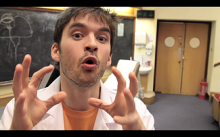COVID-19, Facebook Predicts Hospital Visits, and Quantum Science
(Inside Science) -- In this monthly science recap, Alistair Jennings from Inside Science sums up some of the most interesting monthly science topics. This month we learned a lot about COVID-19. For a start, the new coronavirus can survive up to three days on plastic and stainless steel surfaces and at least three hours in microscopic droplets in the air, although during that time, the amount of viable virus decreases rapidly. New work from Johns Hopkins University suggests that anyone unlucky enough to be infected will begin to see symptoms after, on average, just over five days. The researchers also predict that around 1 in 100 people could go over two weeks before showing symptoms. That’s a problem -- because people can still be infectious during that time, even though they don’t feel sick, and this can lead to undocumented spread of the disease. In China, before the travel lockdown, undocumented spread like this could have been responsible for up to 86% of new infections, according to another new study. Calculating just how dangerous COVID-19 is is quite difficult. Researchers from the University of Hong Kong modeled what the real case numbers could be, based on how many travelers from Wuhan airport tested positive, as well as the initial growth rate of the epidemic. From this they estimate that, as of the end of February, the chance of dying after contracting SARS-CoV-2 was 1.4%. But within that, there is a marked age difference: On average, people aged 60 and older are around five times more at risk than those between 30 and 59.
Also, if you want to find out which of your friends might have been infected -- a good place to look might be Facebook. That's because people change the style of their Facebook language in the days leading up to a hospital emergency department visit. An algorithm trained to analyze people’s Facebook vocabulary found less swearing, less informal language like “lol” and “ur,” and more words associated with family like “baby” and “ma,” as well as more anxious language. Knowing these trends, the algorithm could predict the times when Facebook users would go to the hospital. The researchers who ran the study hope that this kind of data mining of social media could help health care workers predict potentially at-risk patients, before they even choose to come in.
And lastly -- let’s step back from pandemics and predictions and take a trip into the quantum realm. The subatomic particles that live down here have a property called spin. We can use this spin to our advantage, to tell us about the environment that a particle is in, for example, like with MRIs, or to store information, as in quantum computing. Up until now, to manipulate spin, we’ve had to use powerful magnetic fields -- that is until a team of physicists trying to do this mistakenly blew up their own magnet and transformed this area of quantum science. They mistakenly created a powerful electric field, which could change a particle’s spin itself. This kind of electric control of spin had been suggested before, back in the 1960s, but never shown.
References:
1 - https://www.nejm.org/doi/10.1056/NEJMc2004973
3 - https://science.sciencemag.org/content/early/2020/03/24/science.abb3221
4 - https://www.nature.com/articles/s41591-020-0822-7

